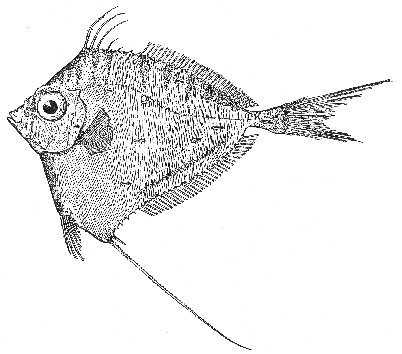Grammicolepid Xenolepidichthys americanus Nichols and Firth 1939
[Nichols and Firth, Proc., Biol. Soc., Washington, vol. 52, 1939, pp. 85-88.]

Figure 157.—Grammicolepid (Xenolepidichthys americanus), Georges Bank. Drawing by H. B. Bigelow. Tail fin after the original illustration by Firth and Nichols.
Description—
This curious little oceanic fish resembles its near relative the John Dory (p. 297) in the arrangement of its fins, and in general shape, with body so strongly flattened sidewise as to be as thin as a pancake, and with a slender caudal peduncle. But it has a much smaller mouth than the John Dory, its scales are linear in shape with their long axis dorso-ventral, so that the sides of the trunk are cross marked with a large number of narrow lines, closely crowded together, and the series of bony plates that arm the dorsal and ventral edge of the body of the John Dory are replaced in the Grammicolepids by a double series of short thorns that embrace the bases of the dorsal and ventral fins. Each side of the trunk of the only species known from our waters is [page 300] armed with about 11 or 12 conspicuous, horizontally flattened spines, pointing rearward.
Size—
The only specimen yet seen is about 4 inches (100 mm.) long, to the base of its tail fin.
We need only add, further, of our species, that the forward division of the dorsal fin consists of 5 spines, the forward edge of the first saw-edged, and all of them filamentous toward the tip; that the second dorsal fin, of 33 soft rays (separated from the first by a considerable gap), is about as high as two-thirds the diameter of the eye; is of about equal height from end to end, and reaches back to the caudal peduncle; that the tail fin is deeply forked, its tips pointed, and its upper lobe longer than the lower (unless this is the result of mutilation); that the soft-rayed anal fin, corresponding to the second (soft) dorsal fin, is preceded, after a considerable gap, first by a short, smooth spine, then by another very long spine, saw-toothed along both its front margin and its rear margin for most of its length, but filamentous toward its tip; and that the ventral fins, of 1 stout, saw-edged spine followed by 6 soft rays, stand a little in advance of the brush-shaped pectorals.
Color—
After preservation in alcohol, the color is "pale, with a series of dark marks on the midline of the back, and about 10 narrow dark bands extending downward from these to the level of the top of the eye... the flattened spines, scattered over the body are blackish. Base of anal with a series of dusky blotches, and posterior part of caudal dusky".[41]
Range and occurrence in the Gulf of Maine—
So far known only from Georges Bank, where the only specimen yet seen was picked up, in a bucket, from the Sword Fisherman America. A closely related species, X. dalgleishi Gilchrist 1922, is known from the Caribbean, South Africa, and the Philippines.